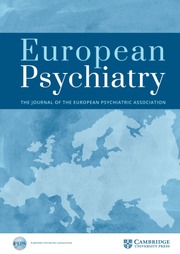No CrossRef data available.
Article contents
1770 – Pattern Of Tobacco Use And Psychopathology In Patients With Schizophrenia And Bipolar Disorder That Participated In Multicomponent Smoking Cessation Program
Published online by Cambridge University Press: 15 April 2020
Abstract
People with schizophrenia and bipolar disorder are more likely to smoke, smoke more cigarettes per day and have greater mortality from smoking-related disease than those in the general population.
To describe the sample and to identify the relationship between the pattern of tobacco use and psychopathology.
Multicenter, observational, prospective, 12-month follow up study to assess the clinical efficacy of a multicomponent smoking cessation program specifically designed for patients with severe mental illness.
65 patients from 3 Mental Health Centers sited in Spain [64.6% males; mean age (SD) = 44.63 (8.93)].
(1) Pattern of tobacco use: Fargerstrom Test for Nicotine physical Dependence; Glover-Nilsson Test for Nicotine psychological Dependence; expired carbon monoxide (CO); n° cigarettes/day; n° smoking years.
(2) Psychopathology: PANSS; Hamilton; Young; CGI-G.
Schizophrenia 64.6% and bipolar 26.2%; suicide attempts 36.9% (2.83 mean of suicide attemps); economically active 7.7%. There is no differences: in psychopatology severity between “heavy smokers” (ppm ≥ 26 or n° cigarettes/day ≥ 30) and “non heavy smokers” (ppm < 26 or n° cigarettes/day < 30) and in the pattern of tobacco use between schizophrenia and bipolar patients. There is no relationship between psychopatology severity and the pattern of tobacco use in schizophrenia patients. Finally, there is relationship between depressive symptoms (Hamilton) and nicotine psychological dependence (Glover-Nilsson Test) in bipolar disorder patients (r = 0.72, p = 0.004).
In bipolar disorder patients, there is relationship between the severity of depressive symptoms and the dependence of nicotine.
Information
- Type
- Abstract
- Information
- European Psychiatry , Volume 28 , Issue S1: Abstracts of the 21th European Congress of Psychiatry , 2013 , 28-E1035
- Copyright
- Copyright © European Psychiatric Association 2013


Comments
No Comments have been published for this article.